February 03, 2007History is Demographics
But somehow, when a fuse is lit under Lebanon it remains peaceful, while Palestine blows up. Here is a simple graph that explains the physics of conflict. Sons and World Power In his (eccentric) book Söhne und Weltmacht, (Sons and World Power) University of Bremen historian Gunnar Heinsohn argues that the there is a simple explanation that lies behind conflicts as diverse as modern Palestine, Sudan, the 1980's civil war of El Salvador, the 1960's Cultural Revolution in China, the 1940's Imperialism of Japan, the 1490's Crusades from Europe, and the 1770's American Revolution. The cause? An excess population of 15-to-29-year-old men. A "youth bulge". 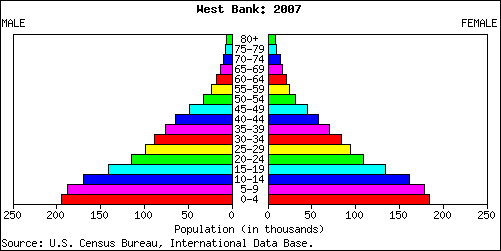 You can see a youth bulge by plotting a country's population pyramid. As you can see above, Palestine is suffering through an enormous youth bulge. Yet Lebanon's youth bulge has passed. Heinsohn's prediction is that Lebanon will not have a second civil war, simply because it does not have the demographics needed to support conflict.  Lebanon's demographics are very different from those in the West Bank, but, interestingly, today's West Bank looks almost exactly like Lebanon in 1975, that is, Lebanon as it stood on the brink of fifteen years of civil war.  While Heinsohn's explanations and conclusions run the danger of oversimplifying the causes of war, it does seem clear that he is right in one thing: population pyramids are worth watching. Population Pyramids at Other World Hotspots Let us take a look at the demographics of other hotspots around the world.  The population pyramid for today's Iran reveals a 15-29-dominated culture that suggests a potential for volatility. But the fertility rate has been dropping, and unless Ahmadinejad succeeds in his effort to alter Iranian family planning policy, in ten years, Iran's youth bulge will have passed. 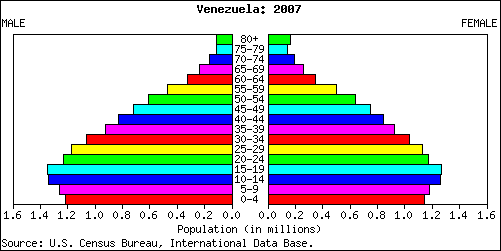 The Iranian situation is not unlike Venezuela and Mexico, which are young but which will have aged enough in 15 years that they will resemble today's Brazil. 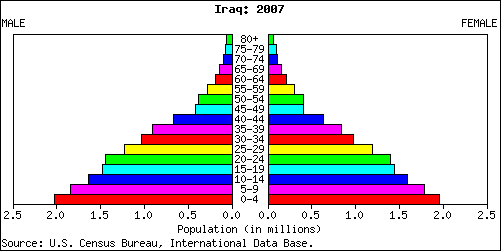 Today's youthful Iraq, on the other hand, will still be just as young in twenty years, which does not bode well for the end of civil war in that unfortunate nation. 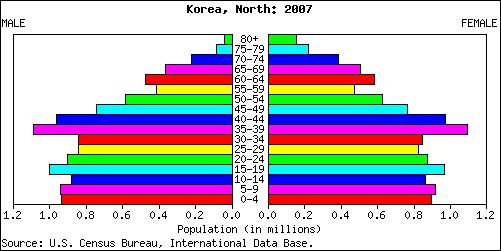 Despite the talk about danger on the Korean peninsula, neither the North nor the South appear demographically armed for conflict. Nor is China in the mood for trouble. These are all countries full of middle-aged people, like the United States. The same sort of picture suggests that when Castro passes away, an aged Cuban population will not rise in violence. 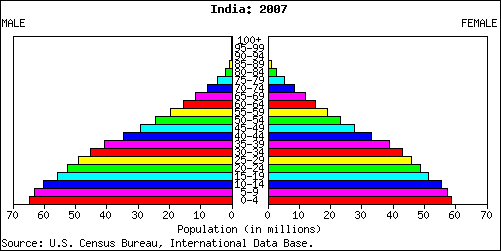 India and Pakistan, on the other hand, are a real cause for worry. Not only do the two nuclear states have a history of conflict; they are demographically armed to the teeth, with a youth bulge that will persist for years. Perhaps the world should spend more effort to try to defuse that powder keg. 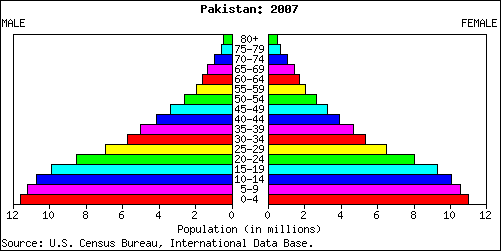 More Demographic Visualization As you can see, the U.S. Census Bureau has a nice tool for taking a peek at population pyramids from around the world. Really, what I'd like is for a tool to be able to plot and animate this sort of data more quickly on a global scale. Something like a Gapminder animation. What is Gapminder? It is a Swedish foundation that has developed some remarkable visualization tools devoted to improving understanding of global development. This TED talk by Gapminder founder Hans Rosling is worth a watch. It is a real eye-opener. The most striking four-dimensional visualization tool presented by Rosling is something you can play with online at tools.google.com/gapminder. I would very much like to plot population pyramids on Gapminder's scatterplots, and I am looking forward to Gapminder's continuing work. Posted by David at February 3, 2007 07:33 AMComments
Cool stuff. I'l have to come back and noodle around a bit with the video. Posted by: mapgirl at February 5, 2007 10:49 AMInteresting observation and FASCINATING video. I’m puzzled by the psychology behind the data. Are the 19-25’s more likely to incite uprisings? Are the older leaders thinking there are enough young males to fight and win? What is going through their minds? Posted by: Roger at February 5, 2007 05:07 PMI'm fascinated by the count of Lebanese men to women in 2007 for the 50-54 age group. It's very sad to think that there are many fathers/brothers who were alive 30 years before and died prematurely due to conflict. I still haven't watched the video though. Keep meaning to do that. There's a lot of demographic work about social security and whether or not the current population can sustain the baby boomers in their retirement. (Gotta work in the personal finance angle here.) Makes for interesting policy work. Posted by: mapgirl at February 7, 2007 03:36 PMI am very impressed by the "Youth Bulge" theory that appears to explain much that is mysterious to most of us. It even explains the lack of violence by Mexican immigrants vs. the U.S. - there is no significant movement to reclaim "captured" terrotory form the gringos bacuase the current birth rate in Mexico is almost the same as in the U.S. - about 2.3. cool Posted by: at September 23, 2008 02:58 PMwhy didn't you throw Israel in there too? Posted by: vic at January 15, 2010 02:38 AMThe various links to census.gov no longer work. Posted by: Sam Humbert at June 23, 2010 11:57 AMDavid, thanks for this great article - visualization really makes a difference in intuitively grasping the significance of the youth bulge theses. Thanks especially for the hint at gapminder and Hans Rosling, which I didn't know before. Gapminder is a great tool, and I found Roslings presentations extremely enlightening. Posted by: Moneymind at October 13, 2012 04:25 PMI havenˇt checked in here for some time as I thought it was getting boring, but the last several posts are good quality so I guess I will add you back to my daily bloglist. You deserve it friend :) Post a comment
|
| Copyright 2007 © David Bau. All Rights Reserved. |
